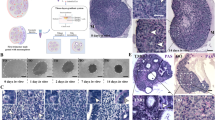A number of years ago we reported that tight junctions between adjacent Sertoli cells subdivide the seminiferous epithelium into two compartments, basal and adluminal, thus forming the morphological basis of the blood-testis barrier. It is now generally believed that the special milieu created by the Sertoli cells in the adluminal compartment is essential for germ cell differentiation. In order to duplicate the compartmentalization that occurs in vivo, Sertoli cells were cultured in bicameral chambers on Millipore filters impregnated with a reconstituted basement membrane. Confluent monolayers of these cells were tall columnar (40–60 µ in height) and highly polarized. These Sertoli cell monolayers established electrical resistance that peaked when the Sertoli-Sertoli tight junctions developed in culture. In addition, the monolayers formed a permeability barrier to 3H-inulin and lanthanum nitrate. The bicameral chambers were utilized in a number of studies on protein secretion, and it was revealed that numerous proteens are secreted in a polarized manner. In another study, hormone- stimulated aromatase activity was measured in Sertoli cells grown on plastic culture dishes, plastic dishes coated with laminin or Matrigel, and in the bicameral chambers. Cell culture on basement membrane substrate decreased the FSH-dependent estrogen production. No estrogen production was observed when the Sertoli cells were cultured in the bicameral chambers. These results are in accord with the hypothesis that differentiated Sertoli cells lose their ability to metabolize androgen to estrogen in an hormone-dependent manner, whereas undifferentiated cells in culture, or in vivo, have a very active FSH-dependent aromatase activity. This bicameral culture system could serve as an important model system to examine various functions of Sertoli cells including interactions of Sertoli cells with germ, Leydig, and myoid cells.
Similar content being viewed by others
References
BYERS, S.W., HADLEY, M.A., DJAKIEW, D., and DYM, M. (1986). Growth and characterization of polarized monolayers of epididymal epithelial cells and Sertoli cells grown in dual environment culture chambers. J. Androl. 7:59–68.
DAI, R.X., DJAKIEW, D., and DYM, M. (1987). Endocytic activity of Sertoli cells grown in bicameral culture chambers. Anat. Rec. 218:306–312.
DAVIS, C.M., PAPADOPOULOS, V., JIA, M.C., YAMADA, Y., KLEINMAN, H.K, and DYM, M. (1991). Identification and partial characterization of laminin binding proteins in immature rat Sertoli cells. Experimental Cell Research. 193:262–273.
DJAKIEW, D. and DYM, M. (1988). Pachytene spermatocyte proteins influence Sertoli cell function. Biology of Reproduction. 39:1193–1205.
DJAKIEW, D., HADLEY, M.A., BYERS, S.W., and DYM, M. (1986). Transferrin-mediated transcellular transport of 59Fe across confluent epithelial sheets of Sertoli cells grown in bicameral cell culture chambers. J. Androl. 7:355–366.
DYM, M., LAMSAM-CASALOTTI, S., JIA, M.C., KLEINMAN, H.K., and PAPADOPOULOS, V. (1991). Basement membrane increases G-protein levels and follicle-stimulating hormone responsiveness of Sertoli cell adenylyl cyclase activity. Endocrinology. 128:116–1176.
HADLEY, M.A., BYERS, S.W., SUAREZ-QUIAN, C.A., KLEINMAN, H.K., and DYM, M. (1985). Extracellular matrix regulates Sertoli cell differentiation, testicular cord formation, and germ cell development in vitro. J. Cell Biol. 101:1511–1522.
HADLEY, M.A., DJAKIEW, D., BYERS, S.W., and DYM, M. (1987). Polarized secretion of androgen binding protein and transferrin by Sertoli cells grown in a bicameral culture system. Endocrinology. 120:1097–1103.
HADLEY, M.A., WEEKS, B.S., KLEINMAN, H.K., and DYM, M. (1990). Laminin promotes formation of cord-like structures by Sertoli cells in vitro. Dev. Biol. 140:318–327.
KLINEFELTER, G.R., HALL, P.F., and EWING, L.L. (1987). Effect of luteinizing hormone deprivation in situ on steroidogenesis of rat Leydig cells purified by a multi-step procedure. Biol. Reprod. 36:769–783.
OJEIFO, J., BYERS, S.W., PAPADOPOULOS, V., and DYM, M. (1990). Sertoli cell-secreted protein(s) stimulates DNA synthesis in highly purified rat Leydig cells in vitro. J. Reprod. Fertil. 90:93–108.
ONODA, M., DJAKIEW, D., and PAPADOPOULOS, V. (1991). Pachytene spermatocytes regulate the secretion of Sertoli cell protein(s) which stimulate Leydig cell steroidogenesis. Mol. Cell. Endocrinol. 77:207–216.
ONODA, M., SUAREZ-QUIAN, C.A., DJAKIEW, D., and DYM, M. (1990). Characterization of Sertoli cells cultured in the bicameral chamber system: Relationship between formation of permeability barriers and polarized secretion of transferrin. Biol. of Reprod. 43:672–683.
SUAREZ-QUIAN, C.A., AN, Q., JELESOFF, N., and DYM, M. (1991). The Golgi apparatus of pachytene spermatocytes during spermatogenesis. Anat. Rec. 229:16–26.
Author information
Authors and Affiliations
Rights and permissions
About this article
Cite this article
Dym, M., Papadopoulos, V. Dual compartment (bicameral) culture: role of basement membrane in epithelial differentiation. Cell Biol Toxicol 8, 55–59 (1992). https://doi.org/10.1007/BF00130511
Issue Date:
DOI: https://doi.org/10.1007/BF00130511




